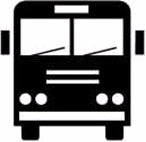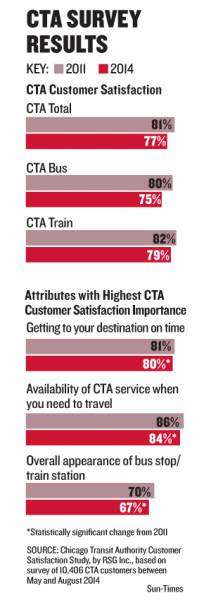3/29/2015, Rosalind Rossi
Chicago Sun-Times Link to Article
CTA spokeswoman Tammy Chase said the new 95th Street Red Line station should hearten South Side L users — and bus riders because of the improved bus staging area there.
The vast majority of customers are satisfied with their CTA service, but fewer feel that way than three years ago — especially if they are bus riders, a study obtained by the Chicago Sun-Times indicates.
Overall satisfaction with Chicago Transit Authority service dropped from 81 percent in 2011 to 77 percent in 2014, the study of survey results showed.
The biggest decline was among bus riders, where satisfaction fell from 80 percent to 75 percent. A North Side-South Side bus divide emerged, with Far South Siders or South Siders the least satisfied and downtown, North Side or Evanston bus riders the most satisfied on three key measuring sticks, the study by RSG Inc. indicated.
And despite the CTA’s 2013 effort to reduce crowding on buses and trains, only 50 percent of riders were satisfied with the amount of “personal space” they got during their rides, survey results showed. That’s 5 percentage points less than before the “de-crowding” effort began.
“Declines in satisfaction with seat availability and amount of personal space mean travelers are feeling more crowded on their trips,” survey analysts for RSG wrote in a Feb. 4, 2015, report prepared for the CTA.
But overall, more than three of every four bus and L riders were satisfied with their CTA service, based on more than 10,400 customers surveyed.
The results are in line with the ratings of peers in New York, San Francisco and New Jersey, CTA spokeswoman Tammy Chase said.
Chase called the 4 percentage point drop in overall satisfaction “slight.” She tied the May-to-August 2014 survey results to the brutal early winter months of 2014 and the bumpy rollout of the CTA’s Ventra fare payment system, which Chase said “fully launched successfully in July.”
Although riders weren’t questioned about Ventra, the report noted more than 400 people mentioned it, most of them negatively. The report speculated some scores “may be the result of residual animosity from customers” unhappy with Ventra but also said Ventra “may not be the only cause of decreases in scores.”
Chase cautioned the survey was a mere “snapshot in time” and said CTA officials are “constantly working to improve service to our customers, and have done so in recent years in a number of ways.”
She pointed to the growing presence of CTA Bus and Train Tracker displays, new and improved rail stations and tracks, and updates to rail and bus fleets. In addition, the new 95th Street Red Line station should hearten not only South Side L users but bus riders who will enjoy an improved bus staging area.
Satisfaction with the CTA fell both overall and on 40 of 45 different service measures between 2011 and 2014.
“While many of these attributes are still achieving satisfactory ratings, special attention should be paid to the more important attributes to ensure this pattern does not continue in the future,” the report warned.
It identified the top three drivers of customer satisfaction as getting to a destination on time; service when a customer needs it; and bus stop or rail station appearance.
The RSG study said some of the CTA’s lowest scores were racked up in the areas of “appearance” and customer “comfort” – things it said could be improved with relatively less money and still reap a “significant effect on overall satisfaction.”
The CTA’s lowest “comfort” scores, for example, emerged in the area of shelter from the weather for riders. Forty-eight percent of bus and rail riders were satisfied with such shelter, an improvement from 45 percent in 2011.
Least happy were Far South Side bus riders, at only 38 percent satisfied.
When it comes to comfort, the study said, “for bus route groups, typically riders on South Side buses are less satisfied.” And in general, the study said, “northern bus groups are more likely to be satisfied overall and with the value of service than southern bus groups.”
Derrick Harris, a community activist and grant writer, said a bus service disparity exists not only geographically but racially, with South Side African Americans in particular getting the short end of the stick.
“There is a disparity,’’ Harris said. “Of course it’s true. And it’s shameful.”
Among the three hottest issues:
Overall appearance.
Worst bus stops were on the Far South Side, with 60 percent satisfied; best were in Evanston, at 80 percent. Worst rail stations were on the Blue Line Forest Park Branch, at 53 percent satisfied; best were on the Brown Line, at 79 percent.
Getting to a destination on time.
Worst bus routes were South Side east-west, at 70 percent satisfied; best were in Evanston, 86 percent. Worst rail was Evanston Purple, 70 percent satisfied; best was Red Line State Street Subway, 91 percent.
Availability.
Worst bus route was Far South Side, at 77 percent satisfied; best was North Side Lake Shore Drive, at 89 percent. Worst rail was Evanston Purple Line, at 81 percent satisfied; best Red Line State Street subway, 94 percent.
Chase dispute the survey’s contention South Side bus riders tended to be less satisfied than riders on the North Side. She said such a finding “contradicts the actual satisfaction numbers.”
In one chart offering a summary of overall service satisfaction, Chase said satisfaction ratings were “pretty even throughout the city.” She noted South Side Lake Shore Drive riders were more satisfied, at 75 percent, than North-South Crosstown riders, at 73 percent.
However, in that same chart, Far South Side riders had the lowest satisfaction rating, at 67 percent, while North Side-Downtown bus riders tied Evanston ones for having the highest satisfaction, at 84 percent. The South Side Lake Shore Drive riders Chase noted as 75 percent satisfied were less happy than their counterpart North Side Lake Shore Drive riders, at 81 percent satisfied.
In another table, Chase said South Side Downtown and South Side Lake Shore Drive bus satisfaction outranked North Side east-west routes. She didn’t mention that the North Side counterparts of the Downtown and Lake Shore Drive routes generally had higher scores than their South Side brethren.
Charles Paidock of Citizens Taking Action for Transit Dependent Riders urged the CTA to address the bus disparity cited by RSG instead of trying to dispute it.
“You can kill the messenger if you wish, but you should take that information and maybe do something with it,’’ Paidock said. “It’s a pretty good indication that there’s some problem there.”
Charles Paidock of Citizens Taking Action for Transit Dependent Riders urged the CTA to address the bus disparity cited by RSG instead of trying to dispute it.
“You can kill the messenger if you wish, but you should take that information and maybe do something with it,’’ Paidock said. “It’s a pretty good indication that there’s some problem there.”
Citizens Taking Action
for Transit Dependent Riders
The next monthly meeting will be on Monday, April 13th, from 7-9:00 PM, at Powell's Bookstore, Halsted and Roosevelt (800 W, 1200 S)
77% of CTA riders satisfied with service — down from 81% in 2011
3 Hottest Issues
Overall Appearance
Getting to a Destination
on Time
Availability
Scores


